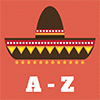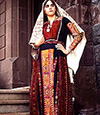Palestine
 Palestinian embroidery styles – and folk clothing styles in general – were formed somewhere around the 2nd-3rd century B.C. and developed throughout the millennia after that. By the 10th century A.D., practically all of the rules, techniques, ornamentation symbols, etc were already established. They changed comparatively little since then. Let’s look at some of the characteristic features of Palestinian needlework. Did you know that a whole lot of European embroidery patterns were brought from the Arab world during the Crusades and incorporated here?
Palestinian embroidery styles – and folk clothing styles in general – were formed somewhere around the 2nd-3rd century B.C. and developed throughout the millennia after that. By the 10th century A.D., practically all of the rules, techniques, ornamentation symbols, etc were already established. They changed comparatively little since then. Let’s look at some of the characteristic features of Palestinian needlework. Did you know that a whole lot of European embroidery patterns were brought from the Arab world during the Crusades and incorporated here?
- Details
- Category: Palestine
- Hits: 21893
 Palestinian traditional clothing culture is so rich and admirable, it has inspired for centuries the tailors and fashion designers not only in Palestine itself but far across its borders to create masterpieces using Palestinian authentic embroidery patterns, traditional silhouettes and shapes of garments, typical colors, and breathtaking jewelry pieces. Most people around the world know too little about the beauty of Palestinian clothing traditions. We’d like to correct this injustice at least partly, so this material will reveal a few curious secrets of the folk costume of Palestine and its influence on European medieval and 18th-19th century fashion.
Palestinian traditional clothing culture is so rich and admirable, it has inspired for centuries the tailors and fashion designers not only in Palestine itself but far across its borders to create masterpieces using Palestinian authentic embroidery patterns, traditional silhouettes and shapes of garments, typical colors, and breathtaking jewelry pieces. Most people around the world know too little about the beauty of Palestinian clothing traditions. We’d like to correct this injustice at least partly, so this material will reveal a few curious secrets of the folk costume of Palestine and its influence on European medieval and 18th-19th century fashion.
- Details
- Category: Palestine
- Hits: 9624
 The craft of embroidery in Palestine underwent big changes in the mid-20th century. Why? What geopolitical events were so serious that they influenced the traditional craft that used to be established and changeless for centuries before. Let’s find out. Also, let’s see how the Palestinian needlework has changed and what it looks like today. It’s great that young women in this country and in the diaspora abroad are still interested in traditional embroidery and other crafts. Yes, they alter the patterns and color palette, but they don’t give up doing it. That is how folk art survives in the 21st century.
The craft of embroidery in Palestine underwent big changes in the mid-20th century. Why? What geopolitical events were so serious that they influenced the traditional craft that used to be established and changeless for centuries before. Let’s find out. Also, let’s see how the Palestinian needlework has changed and what it looks like today. It’s great that young women in this country and in the diaspora abroad are still interested in traditional embroidery and other crafts. Yes, they alter the patterns and color palette, but they don’t give up doing it. That is how folk art survives in the 21st century.
- Details
- Category: Palestine
- Hits: 4719
 Palestinian traditional embroidery called “tatriz” can be very different in different regions of the country. Some areas prefer a certain color, others use typical symbolic patterns, or even hide embroidered clothes underneath plain cloaks. Palestine is a comparatively small country but its cultural and historic heritage is huge. And one of the main folk clothing crafts here is needlework. So, let’s try to highlight the major characteristic features of several Palestinian regions here.
Palestinian traditional embroidery called “tatriz” can be very different in different regions of the country. Some areas prefer a certain color, others use typical symbolic patterns, or even hide embroidered clothes underneath plain cloaks. Palestine is a comparatively small country but its cultural and historic heritage is huge. And one of the main folk clothing crafts here is needlework. So, let’s try to highlight the major characteristic features of several Palestinian regions here.
- Details
- Category: Palestine
- Hits: 5151
 It’s always fun to listen to people talking about their folk dress. They can share lots of tiny details and peculiarities that we wouldn’t find out otherwise. That’s why Nationalclothing.org likes to publish the stories of people from around the world who own and wear the traditional costumes of their countries. Today, we offer you a story of a 97-year-old Palestinian woman Jalileh Mansour. She will show us her folk outfit and talk a little about it.
It’s always fun to listen to people talking about their folk dress. They can share lots of tiny details and peculiarities that we wouldn’t find out otherwise. That’s why Nationalclothing.org likes to publish the stories of people from around the world who own and wear the traditional costumes of their countries. Today, we offer you a story of a 97-year-old Palestinian woman Jalileh Mansour. She will show us her folk outfit and talk a little about it.
- Details
- Category: Palestine
- Hits: 5188
 Various regions of Palestine have their own unique clothing traditions. Sometimes, the outfits differ radically, in other cases, there is only so much difference. We’d like to show you some photos of the clothing designs, shapes, and ornamentation from several regions of Palestine. Also, you’ll see how Palestinian designers can combine modern fashion tendencies with authentic features and traditional motifs.
Various regions of Palestine have their own unique clothing traditions. Sometimes, the outfits differ radically, in other cases, there is only so much difference. We’d like to show you some photos of the clothing designs, shapes, and ornamentation from several regions of Palestine. Also, you’ll see how Palestinian designers can combine modern fashion tendencies with authentic features and traditional motifs.
- Details
- Category: Palestine
- Hits: 41188
 Traditional pieces of the male and female national costumes in Palestine: abaya, bisht, burnous, bushnika, damer, dimaya, hata wi ‘agal, izar, jallayeh, jubba, jubbeh, khabara, kuffiyah, laffeh, lavandi, malliaia, qamis, qibar, qumbaz, salta, sirwal, tarbush, tatriz, taqiyyah, taqsireh, and thob.
Traditional pieces of the male and female national costumes in Palestine: abaya, bisht, burnous, bushnika, damer, dimaya, hata wi ‘agal, izar, jallayeh, jubba, jubbeh, khabara, kuffiyah, laffeh, lavandi, malliaia, qamis, qibar, qumbaz, salta, sirwal, tarbush, tatriz, taqiyyah, taqsireh, and thob.
- Details
- Category: Palestine
- Hits: 8604
 The folk clothing of Palestine is extremely rich in embroidery. By the way, the traditional embroidery is called “tatriz”, and it adds a distinctive Palestinian flavor to any dress. The complicated history of Palestine had a considerable influence on the national costume and clothing traditions of this country. But luckily, in modern times, the traditional outfit of Palestine experiences its flourishing. There is a boom of tatriz and Palestinian traditional garments within the country and far beyond its borders. Local manufacturers and Palestinian and Israeli merchants work hard to advertise these folk costumes and export them to every possible interested country of the world. So, let’s try to find out a little bit about this extraordinary folk clothes.
The folk clothing of Palestine is extremely rich in embroidery. By the way, the traditional embroidery is called “tatriz”, and it adds a distinctive Palestinian flavor to any dress. The complicated history of Palestine had a considerable influence on the national costume and clothing traditions of this country. But luckily, in modern times, the traditional outfit of Palestine experiences its flourishing. There is a boom of tatriz and Palestinian traditional garments within the country and far beyond its borders. Local manufacturers and Palestinian and Israeli merchants work hard to advertise these folk costumes and export them to every possible interested country of the world. So, let’s try to find out a little bit about this extraordinary folk clothes.
- Details
- Category: Palestine
- Hits: 78892

